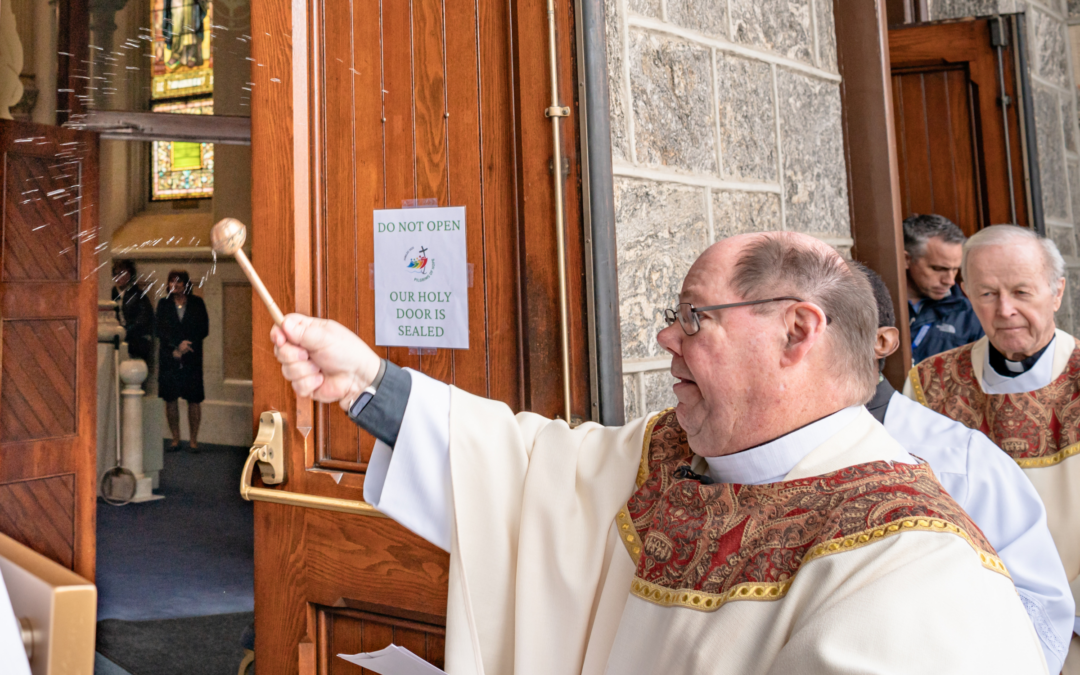Visitors and passersby who gaze upon the Basilica Shrine of Our Lady of the Miraculous Medal in the Germantown neighborhood of Philadelphia throughout the coming year may notice something distinctly different about its stately Romanesque façade.
Banners depicting the colorful emblem of the Roman Catholic Church’s 2025 Jubilee – and its “Pilgrims of Hope” theme – shroud the central doors of the Basilica Shine, and a golden cross symbolically seals those doors shut. The Vincentian priests and brothers who minister there are not trying to keep people out. Rather, they want to embrace the faithful and encourage pilgrimage in preparation for the coming Holy Year.
On Jan. 29, the Basilica Shrine renewed a centuries-old Church tradition by blessing and symbolically sealing its Holy Door. More than 200 worshipers attended the noontime service, which began with the praying of the Perpetual Novena and concluded with the celebration of Holy Mass.
“Jesus says, ‘I am the gate. I am the door.’ And so, the Holy Door that we bless is really not just about the physical door. It reminds us that Jesus is our door,” said Fr. John Kettelberger, CM, who led the blessing and officiated Mass.
“And so every time we see that door and, hopefully, when it is opened during the Holy Year and we go through it, we are being reminded that we have heard Jesus call us by name and that we are eager and anxious to follow him.”
In his homily, Fr. Kettelberger described the Jubilee or Holy Year as a gift from Pope Francis, “a year that [the pope] calls a ‘year of hope,’ hope for God’s pilgrim people.”
“Pope Francis has a vision. People are so preoccupied today with social media, so preoccupied with the busyness of life, so distracted by things that are happening in their life good and bad, that sometimes they lose focus. And so, Pope Francis wants us to use this year to re-focus on Jesus.”
A Centuries-old Tradition
Sealing the Holy Door is a centuries-old tradition constructed on the belief that Catholics must convert their hearts through prayer and reconciliation before hoping to receive the Lord’s blessings in a Jubilee year. Among those sought-after blessings is removal of temporal punishment for one’s sins through a plenary indulgence.
“It’s not going to happen just by walking through that door [in 2025],” Fr. Kettelberger explains.
On the contrary, pilgrims must prepare themselves to receive God’s healing graces by dedicating 2024 to prayer and reconciliation. That means finding new ways to pray and praying with greater intensity, receiving the Sacrament of Reconciliation regularly, repairing relationships in their lives, and seeking a closer relationship with the Lord.
The sealed doors of the Basilica Shrine symbolize their responsibility to fulfill these prerequisites.
“Knock, And the Door Will Be Opened…”
The notion of a door or gate as a symbol of entry into the Lord’s good graces derives directly from the Gospel.
In the parable of The Good Shepherd, as chronicled in the Gospel of John, Jesus instructed the Pharisees, “I am the gate. Whoever enters through me will be saved, and will come in and go out and find pasture.” And on his journey to Jerusalem, as described in the Gospel of Luke, Jesus advised his disciples, “So I say to you, ask and it will be given you; search, and you will find; knock, and the door will be opened for you.”
As a minor basilica – one of just two in the Archdiocese of Philadelphia and 93 in the United States – the Basilica Shrine holds a unique, elevated bond with the Papacy through which it is blessed with exceptional privileges and assumes heightened obligations. One of those privileges is the granting of plenary indulgences on certain days throughout the year.
Individuals who are in a state of grace and who enter the Basilica Shrine through the Holy Door during the 2025 Jubilee may receive plenary indulgences, providing they meet other specific conditions of Church law. Typically, the Holy Door will be unsealed on or about Christmas Eve immediately preceding the Jubilee.
A Year of Pilgrimage
Traditionally, the worldwide Church celebrates a Jubilee or Holy Year every 25 years, in addition to extraordinary years selected by the pope. In 2016, Pope Francis declared the Extraordinary Jubilee of Mercy. That same year, the pope granted bishops around the world the privilege of designating Holy Doors at basilicas and shrines in their own dioceses. Prior to that, only the four Papal basilicas in Rome were permitted to practice the tradition. As such, holy doors and jubilees have traditionally been associated with pilgrimages to Rome, where the faithful would go to pass through a Holy Door.
The concept of a Jubilee or Holy Year has roots in the Old Testament. The formal tradition as we know it began in 1300 with Pope Boniface VIII. Historians are less certain about the origin of the Holy Door tradition within the context of a Jubilee. Records suggest it began in the 15th century at the Lateran Basilica, the seat of the Pope as Bishop of Rome and the Church’s earliest basilica. In 1500, Pope Alexander VI expanded the practice to the other Papal Basilicas (Saint Peter’s, Saint Mary Major, and Saint Paul Outside the Walls).

